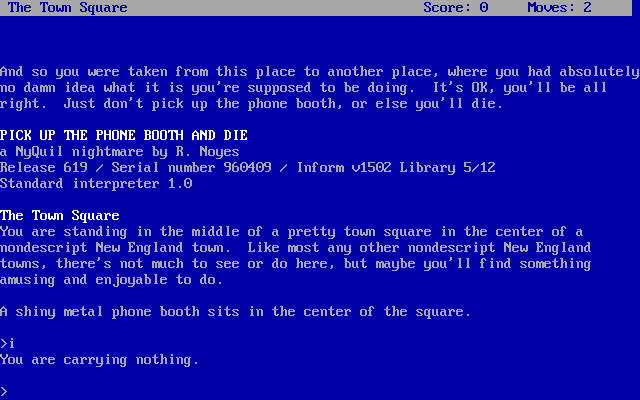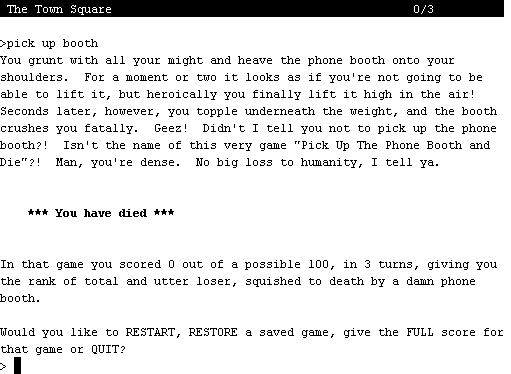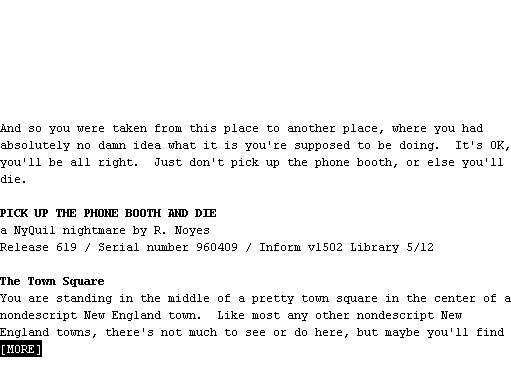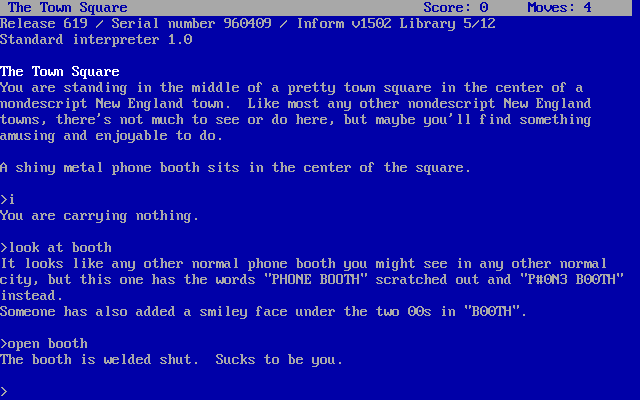Retro Replay Review
Gameplay
Pick up the Phone Booth and Die trades expansive worlds and branching dialogue for a single, tightly focused puzzle. From the moment you spawn in the center of an otherwise empty New England town square, you’re challenged to interact with a shiny metal phone booth that’s been welded shut. There are no hidden inventory menus, no NPCs to question, and no map to consult—just a handful of simple text commands and the booth itself. Your objective is never explicitly stated beyond what’s in the title, forcing you to experiment with every conceivable approach until you stumble upon the solution that yields a satisfying (non-fatal) outcome.
While the interface remains minimalist—entering commands such as “examine booth,” “knock on glass,” or “press button”—the game shines in its responsiveness and the subtle feedback provided after each action. You’ll quickly learn that some inputs are dead ends, leading you right back to the basic “You can’t do that” message, while others yield cryptic snippets of description that hint at possibilities beyond brute force. This design choice turns even the simplest interactions—pushing, pulling, dialing—into moments of genuine curiosity.
Because the entire experience takes place in one location, pacing is critical. The developer accomplishes this by layering small reveals over repeated attempts. Early on, you might only see the welded seams and chipped paint; later, a careful examination might uncover a hidden panel or a loose screw. Every new clue reshapes your understanding of the booth’s mechanics, ensuring that what could have been a one-note puzzle instead plays out like a miniature mystery.
Graphics
Graphically, Pick up the Phone Booth and Die embraces its minimalist roots. There are no 3D models or animations—only crisp, monochrome text punctuated by the occasional ASCII art render of the phone booth’s outline. These simple visuals serve two purposes: they conserve the game’s pared-down aesthetic and direct your focus entirely on the puzzle at hand. If you enter a command that alters the booth, the screen briefly flickers with updated ASCII details, reinforcing the weight of your actions.
Despite—or perhaps because of—this sparse presentation, the atmosphere never feels empty. The stark white background contrasts sharply with the black text, evoking the chilly, open-air stillness of a deserted town square. Ambient audio cues, such as a distant church bell or the rustle of autumn leaves, heighten immersion without ever distracting from the single-item puzzle core. The subtle sound design complements the visuals, making the absence of flashy graphics feel deliberate and even artful.
Some players may yearn for richer visuals, but it’s important to view this title as interactive flash fiction rather than a full-blown adventure game. By stripping away traditional graphical flourishes, the creator forces you to invest in the booth’s narrative potential and to appreciate each small detail rendered in text or ASCII form. In that light, Pick up the Phone Booth and Die’s visuals are not a limitation but a conscious design decision that underscores the game’s minimalist ethos.
Story
On paper, there’s almost no story: you awaken in the middle of a small-town square with one object in front of you. Yet the game’s genius lies in how it teases out a narrative from your interactions. As you poke and prod at the welded-shut booth, you begin to imagine its backstory. Was it sealed off after a crime? Left to rust as a forgotten relic of pre-mobile-phone days? These inferences arise organically from the descriptions you unlock.
Each successful command reveals a new fragment—scratch marks on the interior metal, a faint hum behind the control panel, or the suggestion of a loose coin stuck between the booth’s floor and walls. These narrative breadcrumbs paint a portrait of a town square that may once have been bustling, now reduced to a solitary puzzle stage. By the time you discover the final action that avoids the titular demise, you feel as though you’ve unraveled a tiny local legend.
Though unconventional, the story resonates precisely because it’s never spelled out. Instead, you become the narrator, filling in gaps with your own imagination. This interactive fiction format transforms what could have been a throwaway puzzle into a fleeting but memorable tale. The complete absence of secondary characters or subplots sharpens this effect: every textual detail you receive feels precious, lending weight to the sparse narrative canvas.
Overall Experience
Pick up the Phone Booth and Die is a bite-sized gem for players who relish lateral thinking, brevity, and subtle storytelling. It won’t satisfy those looking for sprawling RPG mechanics or deep branching narratives, but as a standalone logic puzzle it’s elegantly designed. Each successful action brings a small jolt of satisfaction, and the cumulative result—solving the one-step puzzle without triggering the lethal outcome—is surprisingly gratifying.
Replay value lies in sharing and discussing the solution rather than re-experiencing the text. Once you’ve cracked the code, you know precisely how it unfolds. That said, part of this game’s appeal is its social currency: it’s perfect for showing friends, sparking debates about possible alternative endings (there aren’t any), and crowning yourself as the one who “beat” the dead-end title.
In terms of price and commitment, Pick up the Phone Booth and Die demands little. Install, spend ten minutes exploring every command, savor the designer’s cleverness, then move on or replay purely for the fun of seeing hidden ASCII flourishes again. It’s an affordable curiosity, a testament to how interactive fiction can provoke thought and amusement with almost no moving parts. If you appreciate puzzle-driven minimalism and enjoy solving standalone riddles, it’s a quick ticket to a surprisingly rich experience.
 Retro Replay Retro Replay gaming reviews, news, emulation, geek stuff and more!
Retro Replay Retro Replay gaming reviews, news, emulation, geek stuff and more!








Reviews
There are no reviews yet.